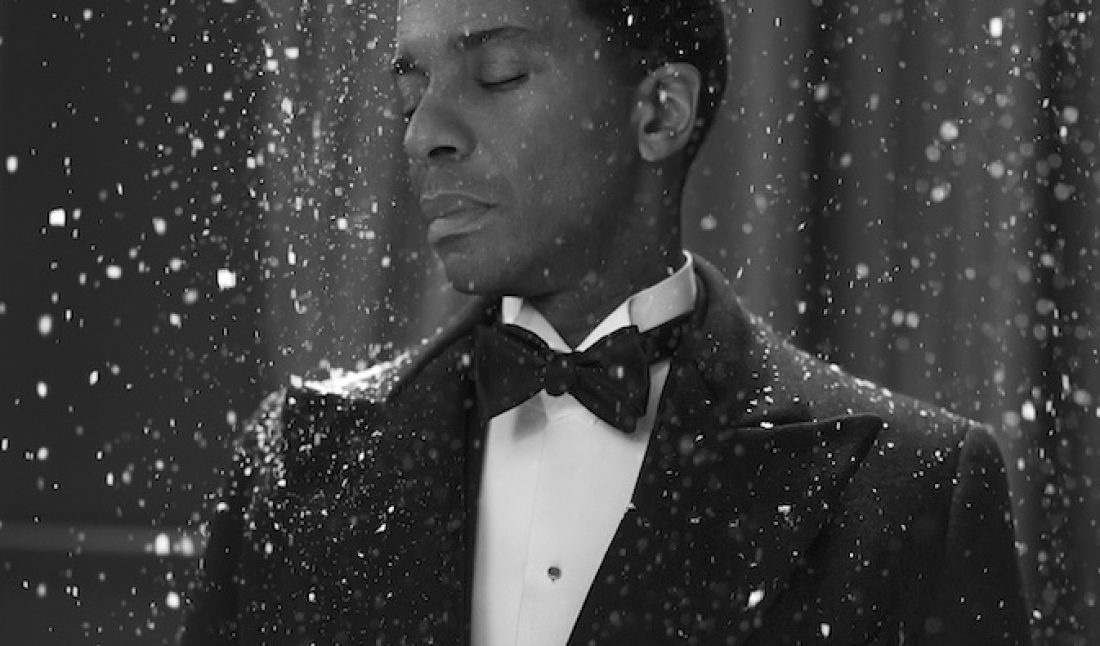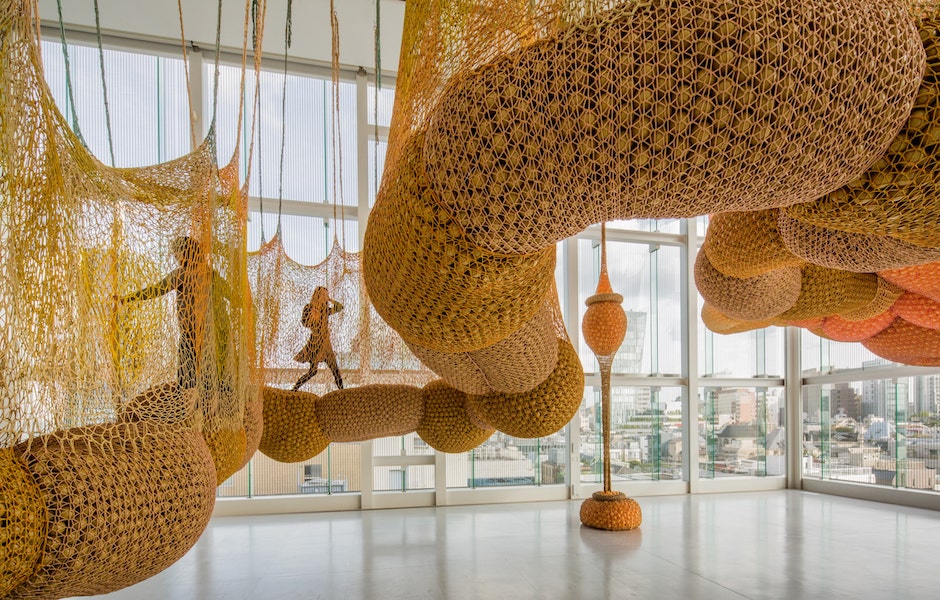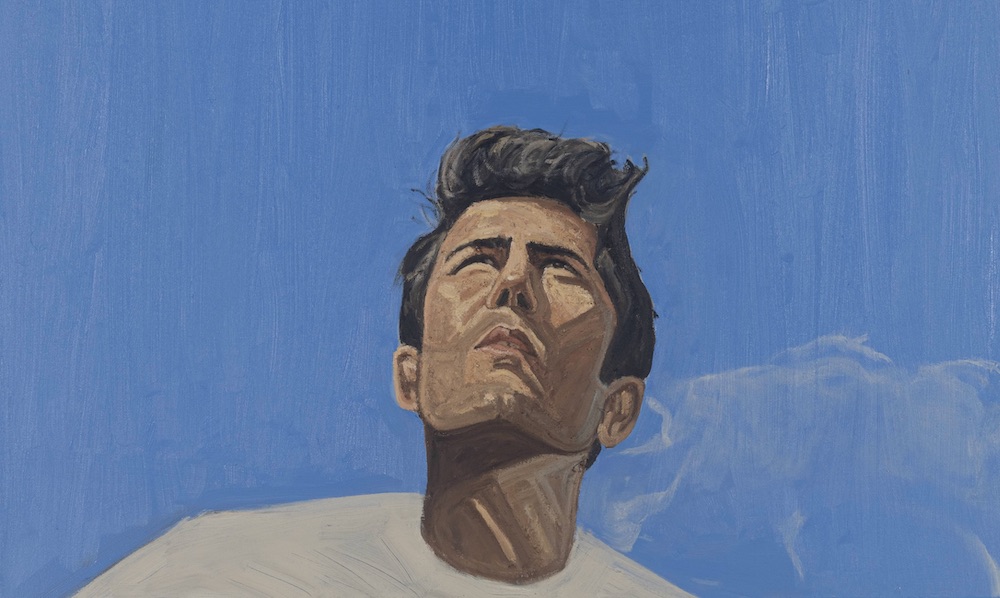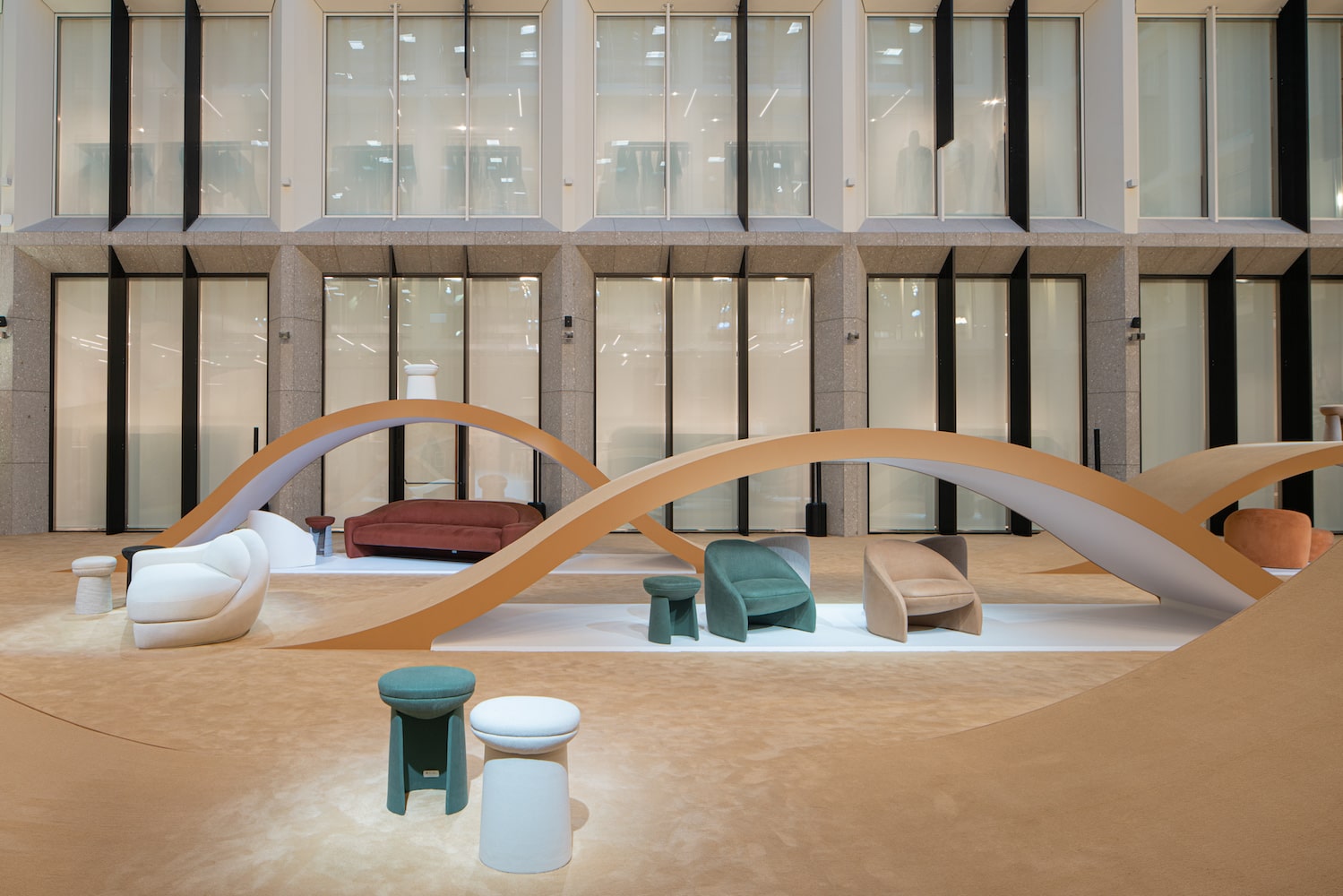Sir Isaac Julien’s Once Again (Statues Never Die), recently on view at the Barnes Foundation in Philadelphia, begins and ends in winter, with a view of snow-covered grounds. Captured in black-and-white, it is a reference to bell hooks’s “Winter,” written for and published in Julien’s 2013 book Riot. “We cannot let the weather determine our fate,” hooks wrote. “Through the snowy, cold . . . everything stopped—I have left time behind . . . surrendered the solidness of our body to become snowflakes, present then dissolving. We are able to shed all the other pieces of our identities that bind and imprison us. . . . As we mature as artists in the mystical diasporic dream-space, a culture of infinite possibility is ready to receive us. This is artistic freedom as pure and unsullied as falling snow.”
Near the close of the film, hooks’s sentiment is poetically captured in a shot of the character Alain Locke, played by actor André Holland, standing with eyes closed, chin tilted toward the sky, caught in an evening snowfall. Julien uses this shot again, dipping back into its beauty, this time reversing the direction of the flakes, the white crystals drifting upward.
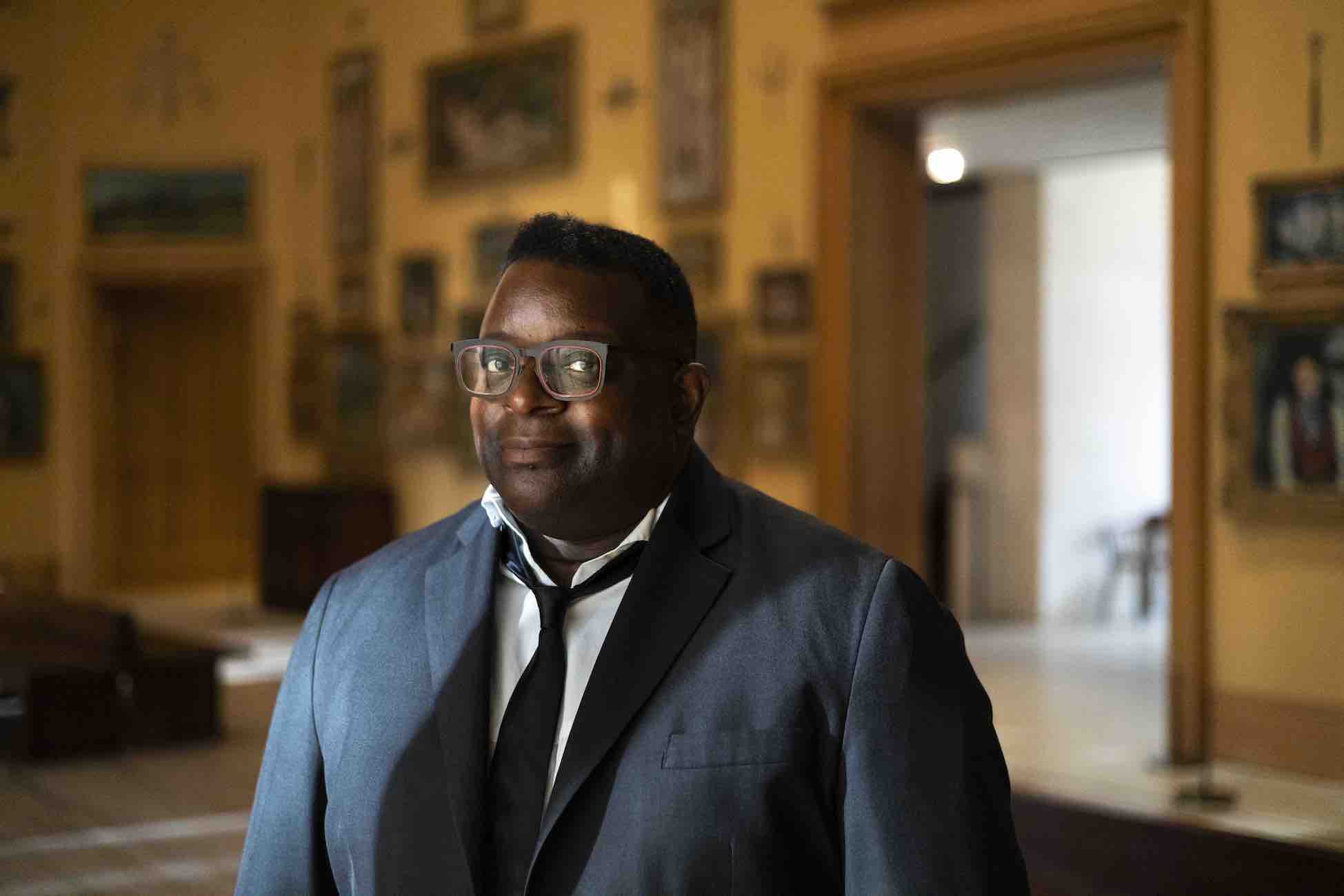 Portrait courtesy of Sir Isaac Julien.
Portrait courtesy of Sir Isaac Julien.
Once Again (Statues Never Die) was commissioned by the Barnes Foundation for its centennial and curated by executive director Thom Collins. It looks at the legacy, friendship, and critical dialogue between the collector and philanthropist Dr. Albert C. Barnes and the “Father of the Harlem Renaissance,” Alain Locke. Barnes was an early patron of African objects, material we know at the turn of the 20th century sparked a revolution in the direction of visual art and culture at large. “The work of the young painters such as Picasso, Modigliani, Soutine, for example, is to a certain extent, the work of the African emotion in a new setting. In the same way the sculpture of Archipenko, Lipschitz and of Epstein is impregnated with Africanism. The music of Bernard, Satie, Poulenc, Auric, Honegger—in short, all that which is interesting since Debussy, is African,” said Barnes in Opportunity magazine in May 1924.
Julien’s film aptly uses that quote, alongside words from Locke, songs by Alice Smith, writings by Aimé Césaire, and more to address our current conversation around monuments and issues of repatriating historical objects. “Thus the African art object, a half a generation ago the most neglected of curios, has now become the cornerstone of a new and more universal aesthetic that has all but revolutionized the theory of art and considerably modified its practice,” said Locke in Opportunity. “The movement has a history. Dumb, dusty trophies of imperialism, assembled from the colonially exploited corners of Africa, first as curios then as prizes of comparative ethnology.”
The exhibition at the Barnes kicks off a number of other shows and programming around Philadelphia for the newly knighted Julien, known for works like Playtime (2013), Ten Thousand Waves (2010), and Looking for Langston (1989). Footage from the latter, set during the 1920s Harlem Renaissance, makes its way into this latest work, as well as its visual language. Whitewall sat down with Julien to hear more about gaining access to the Barnes collection and bringing its archives to life.
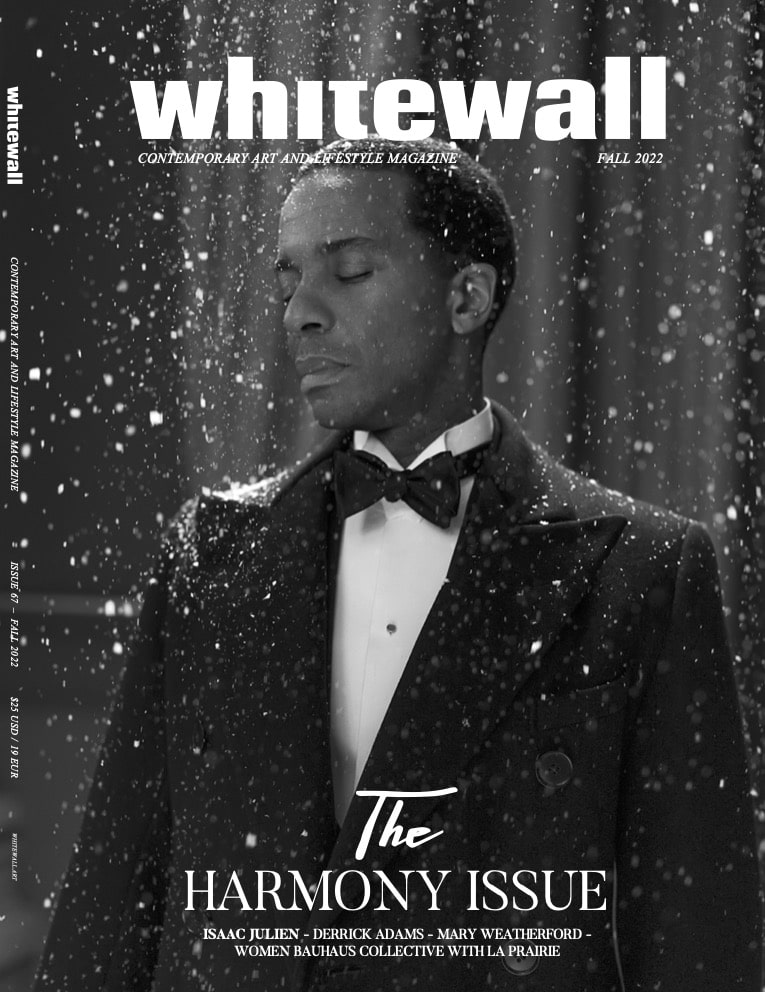 Isaac Julien, “The New Negro Aesthetic” (detail) from “Once Again … (Statues Never Die),” 2022, courtesy of the artist & Victoria Miro, London/Venice, © 2022 Isaac.
Isaac Julien, “The New Negro Aesthetic” (detail) from “Once Again … (Statues Never Die),” 2022, courtesy of the artist & Victoria Miro, London/Venice, © 2022 Isaac.
WHITEWALL: When you were first approached by Thom Collins, what sparked your interest in this commission?
ISAAC JULIEN: Out of serendipity, I was reading The New Negro: The Life of Alain Locke by Jeffrey C. Stewart, and I came across a couple of chapters about his encounters with Barnes. It formed the backbone of the project. The other debate for me was Barnes’s interest in African objects and sculptures, thinking about that in the contemporary sense with all the debates around the restitution of African objects. In particular, the Beninbronzes [violently pillaged by the British empire from the Kingdom of Benin in the late 19th century] became part of the whole framing. How could you make a work about this question now?
During the making of the work, what developed was a harking back to an earlier work I made in 1989, Looking for Langston. It looked at the same period because, of course, Alain Locke featured in some of the archives of that film. Therefore, I came up with the idea about looking at the collection through Alain Locke’s eyes, so to speak.
This could be seen as a prequel to Looking for Langston, is how I view it.
WW: Of creating work around museums, like Vagabondia set in the Sir John Soane Museum in London, you’ve said you’re trying to find the hidden history, the uncanny, in a museum. What hidden history, what uncanny did you find at the Barnes?
IJ: With this piece, it’s also to do with the actual way the scenography is developed—the use of the Mylar walls, reflecting the screens, and the kind of sculptures to create a space of fantasy. The mirroring aspects bring up an uncanniness. There is a troubling of the image and a troubling of what you’re looking at, and a spectatorial play, you could say.
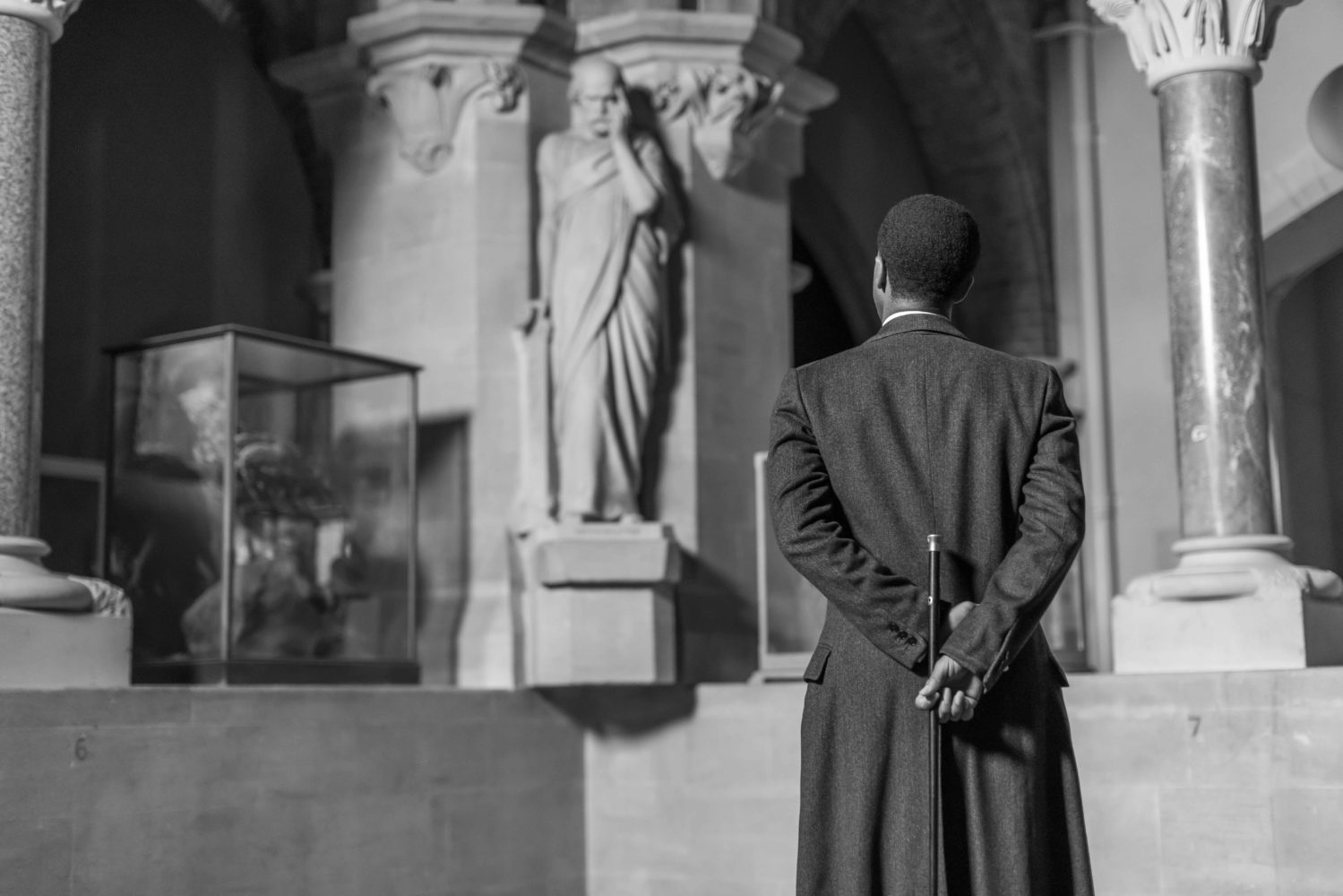 Isaac Julien, “Once Again … (Statues Never Die),” 2022, courtesy of the artist & Victoria Miro, London/Venice, © 2022 Isaac Julien.
Isaac Julien, “Once Again … (Statues Never Die),” 2022, courtesy of the artist & Victoria Miro, London/Venice, © 2022 Isaac Julien.
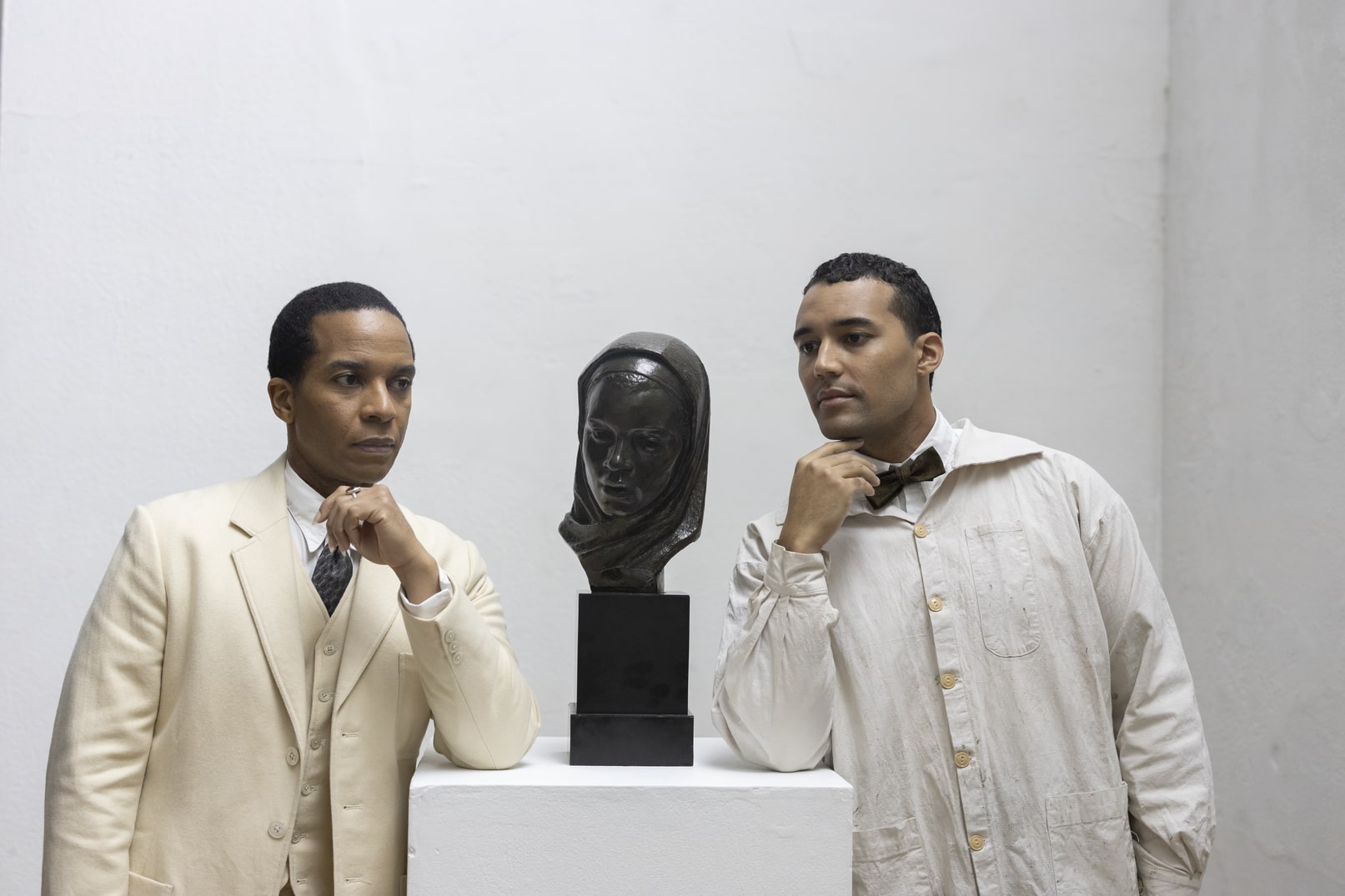 Isaac Julien, “Once Again … (Statues Never Die),” 2022, courtesy of the artist & Victoria Miro, London/Venice, © 2022 Isaac Julien.
Isaac Julien, “Once Again … (Statues Never Die),” 2022, courtesy of the artist & Victoria Miro, London/Venice, © 2022 Isaac Julien.
WW: Right, the film is installed across several screens, reflected in mirrored walls and framed by African art objects from the collection, as well as figurative sculptures by Richmond Barthé. How were you thinking about the scenography?
IJ: I’m hoping that through the film and the actual sculptures themselves, you can see what is the aesthetics and the poetics of the restitution of the works, as opposed to how they are ordinarily viewed. I’m hoping these two things bring out a tension of those different viewing relations in the piece. I’m hoping, as well, when circumnavigating, that you’re looking and getting recapitulated in some other manner.
I’m thinking about that relationship between sculpture and that correspondence between how African American or Black artists of the West developed their own language. And then that relationship both to European modernism and also to the African objects, the intergenerational conversations between Matthew Harrison, Richmond Barthé, and those original sculptures which would be part of the Barnes collection.
WW: You mentioned this idea of “poetic restitution.” How do you see your films in relationship to poetry?
IJ: What we’re trying to do in this work is to continue that trajectory of looking at texts from let’s say, a modernist period, like Césaire, writing about African objects, that first encounter of poets and writers from the diaspora responding. And thinking about that conversation now, which is a very different one. I came across all of those writers and thinkers when I was making works like Looking for Langston. There’s a continual reoccurring thematic that develops. All of those things intertwine in the making of the work and enabled me to join the thoughts.
I see the works as being a form of political lyricism. I think about the idea of songs as being a motif in the work. I think we were searching for text that would reverberate in this manner, that it could be polemical. A lot of the texts that get produced around these kinds of contemporary debates are always in a more prose style, which I think makes it become a different sort of argument. I didn’t feel like it was the right form in relation to the way in which I was thinking about the images and how that might reverberate.
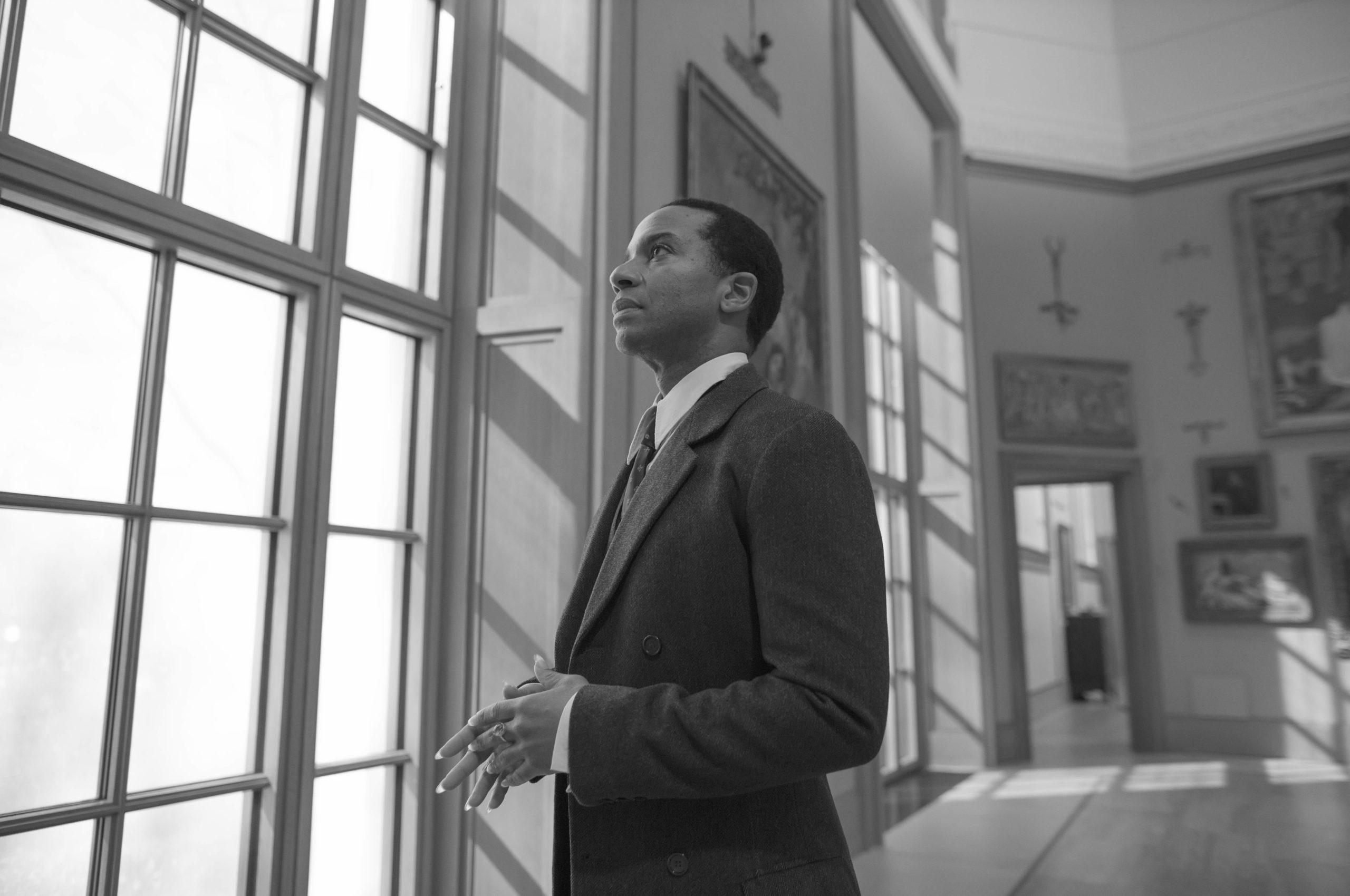 Isaac Julien, “Once Again … (Statues Never Die),” 2022, courtesy of the artist & Victoria Miro, London/Venice, © 2022 Isaac Julien.
Isaac Julien, “Once Again … (Statues Never Die),” 2022, courtesy of the artist & Victoria Miro, London/Venice, © 2022 Isaac Julien.
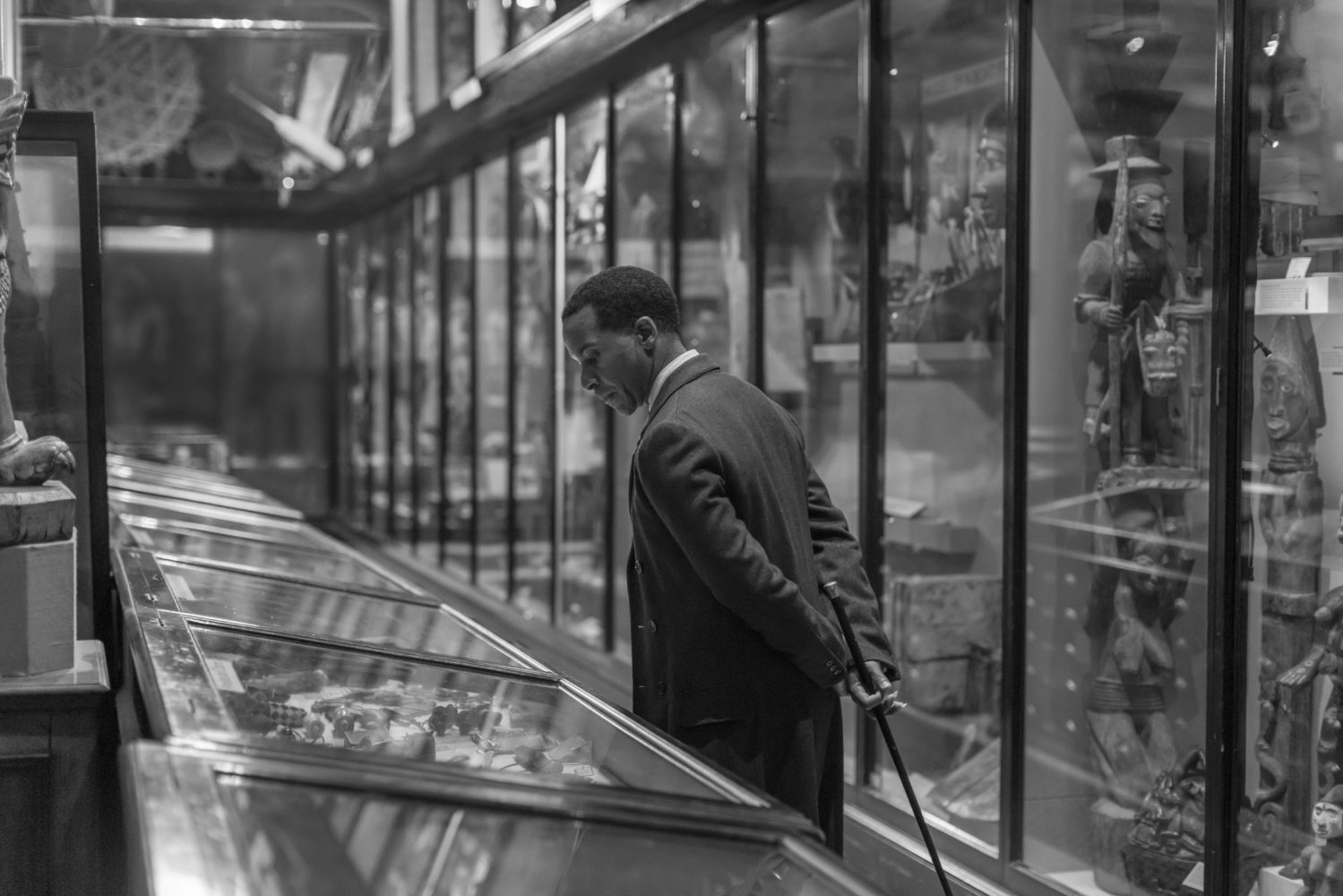 Isaac Julien, “Once Again … (Statues Never Die),” 2022, courtesy of the artist & Victoria Miro, London/Venice, © 2022 Isaac Julien.
Isaac Julien, “Once Again … (Statues Never Die),” 2022, courtesy of the artist & Victoria Miro, London/Venice, © 2022 Isaac Julien.
WW: Can you tell us about the visual theme of winter we see?
IJ: Those images came up thinking about winter as a motif for the changeable nature of both the environment and societal attitudes toward Black subjects in the diaspora. It’s a winter motif both visually and sonically. I came across a text written by the late bell hooks called “Winter,” which was published in the book we made, Riot.
I began to think about how weather could be a commentary for different themes. All of that goes back to Christina Sharpe’s book In the Wake. The question of the weather is also incorporated into Alice Smith’s song [for the film] about that kind of changeability. It’s thinking about how we can look at that as a metaphor for thinking about other questions which are not just to do with say, questions of racism, but questions of desire, and possibilities for other forms of reckoning and recognition. I think that’s what you get in the bell hooks text. Who, of course, the film is dedicated to.
WW: As an artist, what was it like to revisit a work that’s over 30 years old now, Looking for Langston?
IJ: There’s a connection between Alain Locke—my early encounters of him and thinking about that in relationship to Alain Locke today. The appropriation of the Looking for Langston archive and images is also a reflection on the fact that people who participated in Looking for Langston like Blackberri the musician, died this year. And so there’s a looking back as a mature artist, and looking at these themes. The title, Once Again. . . , is also referring to the fact that some of these conversations have been had in the past. There’s a revisitation of them, in the same way you might revisit one’s earlier explorations of themes in film.
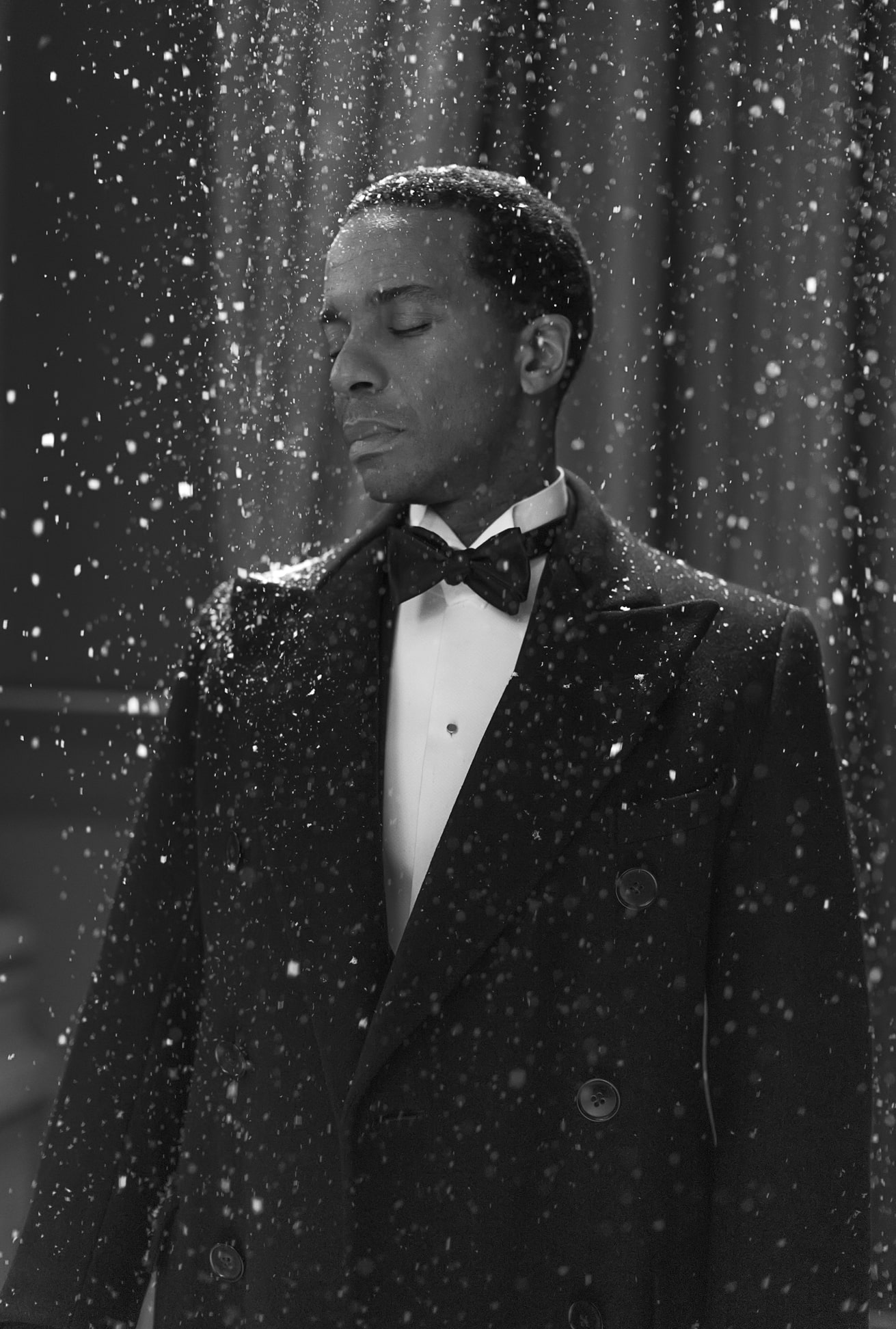 Isaac Julien, “The New Negro Aesthetic” (detail) from “Once Again … (Statues Never Die),” 2022, courtesy of the artist & Victoria Miro, London/Venice, © 2022 Isaac.
Isaac Julien, “The New Negro Aesthetic” (detail) from “Once Again … (Statues Never Die),” 2022, courtesy of the artist & Victoria Miro, London/Venice, © 2022 Isaac.
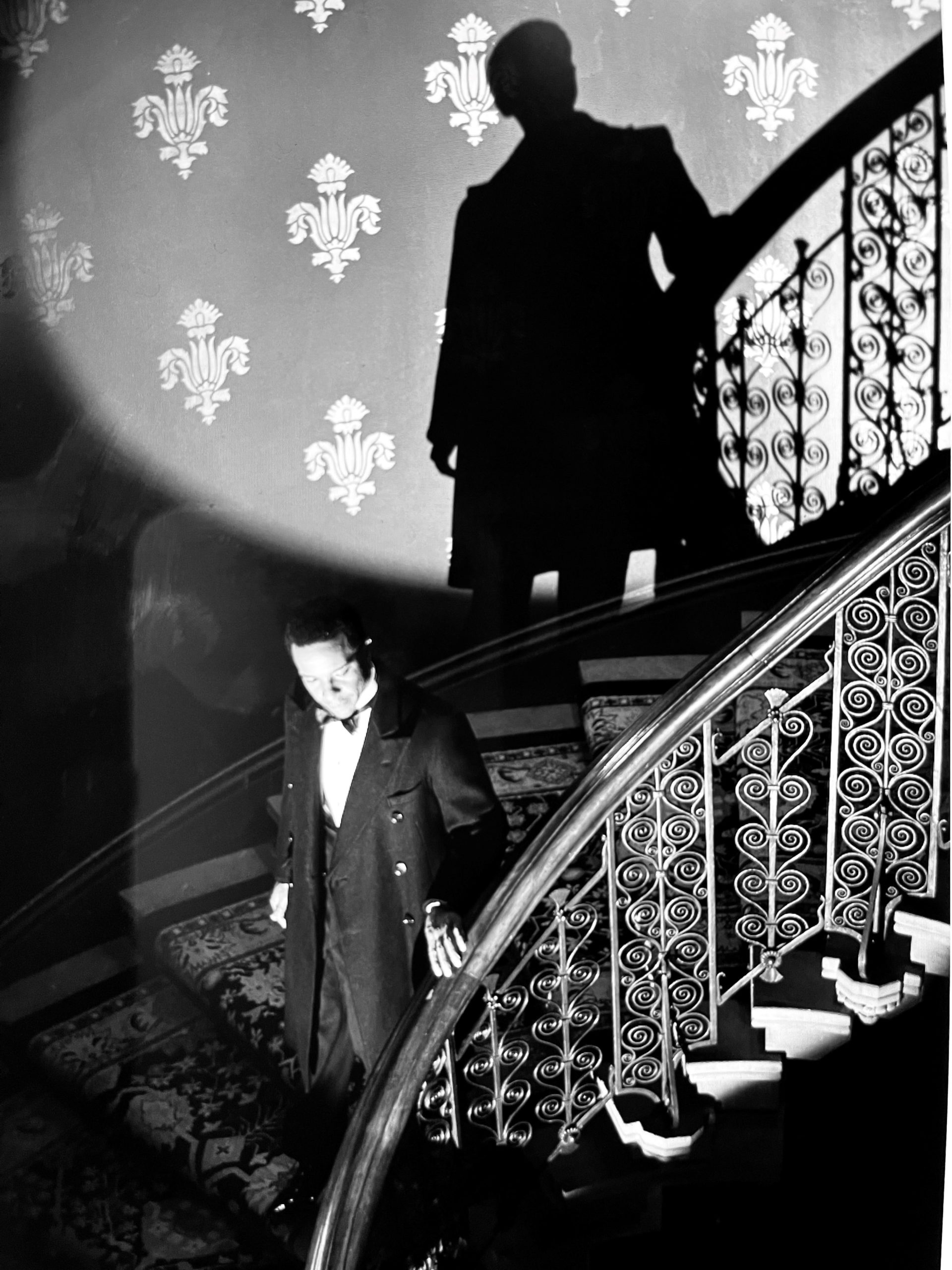 Isaac Julien, “Once Again … (Statues Never Die),” 2022, courtesy of the artist & Victoria Miro, London/Venice, © 2022 Isaac Julien.
Isaac Julien, “Once Again … (Statues Never Die),” 2022, courtesy of the artist & Victoria Miro, London/Venice, © 2022 Isaac Julien.






